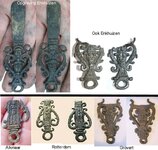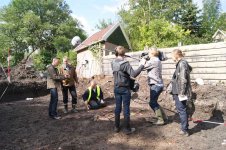woody50
Bronze Member
- Jun 21, 2007
- 1,881
- 206
- Detector(s) used
- XP Deus
- Primary Interest:
- All Treasure Hunting
Another Strange pewter object…
This fragment was found in Holland, the top part was broken off. We wondered what it was, it is from pewter but has figures on both sides of it and both sides have different subjects.
THis fragment is shown below next to the larger complete object.
While trying to find out what it was used for I came across a few others, two of which were complete. One of the complete ones came from the same city and it was found during an archeology dig.
I have now discovered another 5 ‘about the same’ fragments that have been found by our collages.
Here is a photo of most of the objects found, they sort of look alike, pretty sure they were used for the same purpose (but what?). Two of the objects are in the depots from an archeology service; the others are in private collections.
Wondering if anyone knows what it could be.
On a Dutch forum the guesses that people have made ‘what it is’ or ‘what it was used for’ are:
Baby rattle
A belt hanger
A shoe horn
A Spatula
Medical instrument
A soother for a child
Something to fold paper with
Until now none of the above ‘guesses’ can be substantiated.
The measurements of the complete object are:
Material Pewter
Weight 28 gram
Length 110 mm
The widest point 32 mm
The flat part widest point 17 mm
The flat part length from top to the decoration is 44 mm
The object next to the complete one was found in the same city, and has the same decoration and measurement as the complete object.
I do realize that a few have been found in Holland, and my guess is that it could be just a Dutch product. But just maybe something like this exists or existed in England.
The estimate is that the object is from the 16[SUP]th[/SUP] century.
Any guesses are welcome!
Greetings Earl
This fragment was found in Holland, the top part was broken off. We wondered what it was, it is from pewter but has figures on both sides of it and both sides have different subjects.
THis fragment is shown below next to the larger complete object.
While trying to find out what it was used for I came across a few others, two of which were complete. One of the complete ones came from the same city and it was found during an archeology dig.
I have now discovered another 5 ‘about the same’ fragments that have been found by our collages.
Here is a photo of most of the objects found, they sort of look alike, pretty sure they were used for the same purpose (but what?). Two of the objects are in the depots from an archeology service; the others are in private collections.
Wondering if anyone knows what it could be.
On a Dutch forum the guesses that people have made ‘what it is’ or ‘what it was used for’ are:
Baby rattle
A belt hanger
A shoe horn
A Spatula
Medical instrument
A soother for a child
Something to fold paper with
Until now none of the above ‘guesses’ can be substantiated.
The measurements of the complete object are:
Material Pewter
Weight 28 gram
Length 110 mm
The widest point 32 mm
The flat part widest point 17 mm
The flat part length from top to the decoration is 44 mm
The object next to the complete one was found in the same city, and has the same decoration and measurement as the complete object.
I do realize that a few have been found in Holland, and my guess is that it could be just a Dutch product. But just maybe something like this exists or existed in England.
The estimate is that the object is from the 16[SUP]th[/SUP] century.
Any guesses are welcome!
Greetings Earl
Amazon Forum Fav 👍
Attachments
Last edited:













